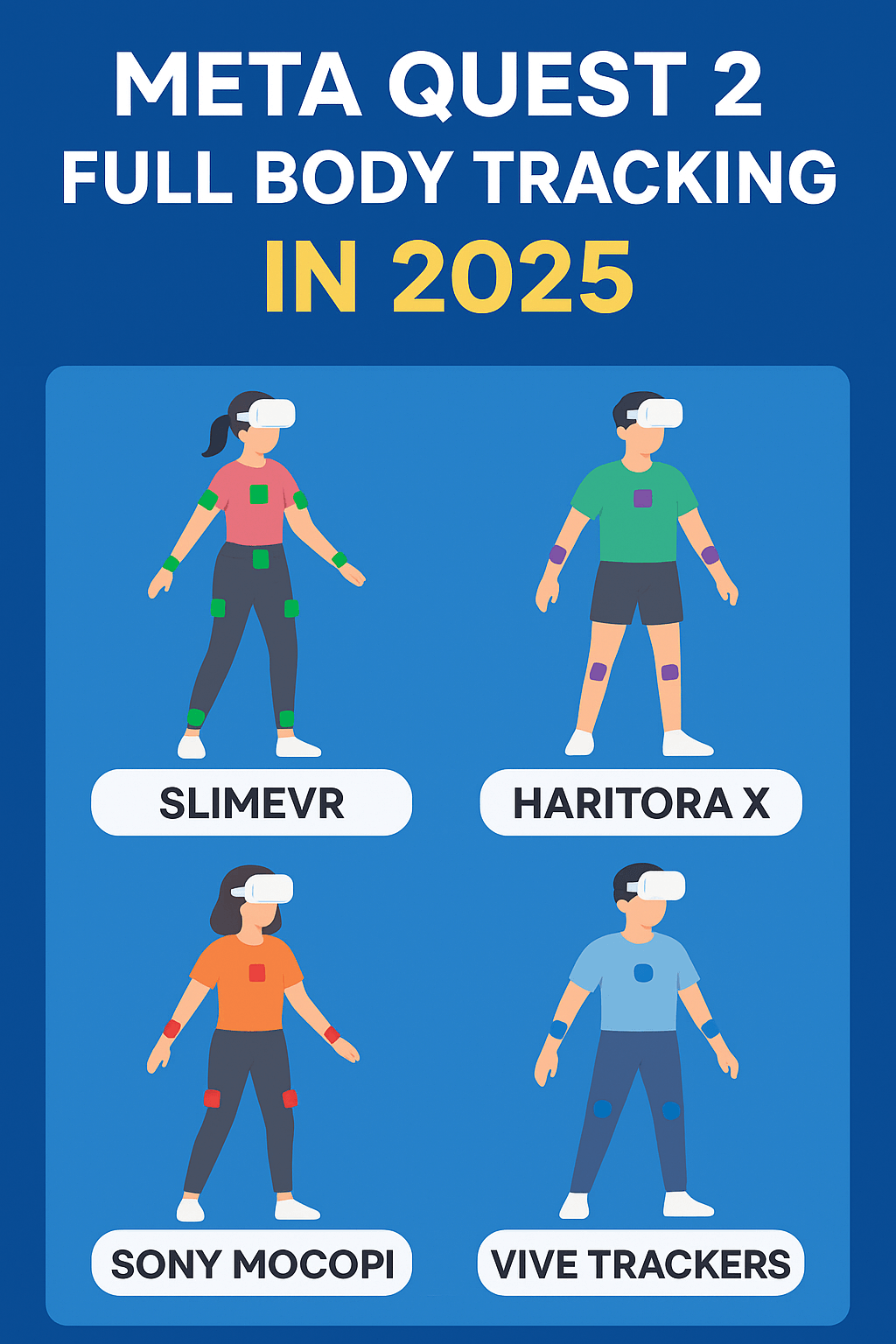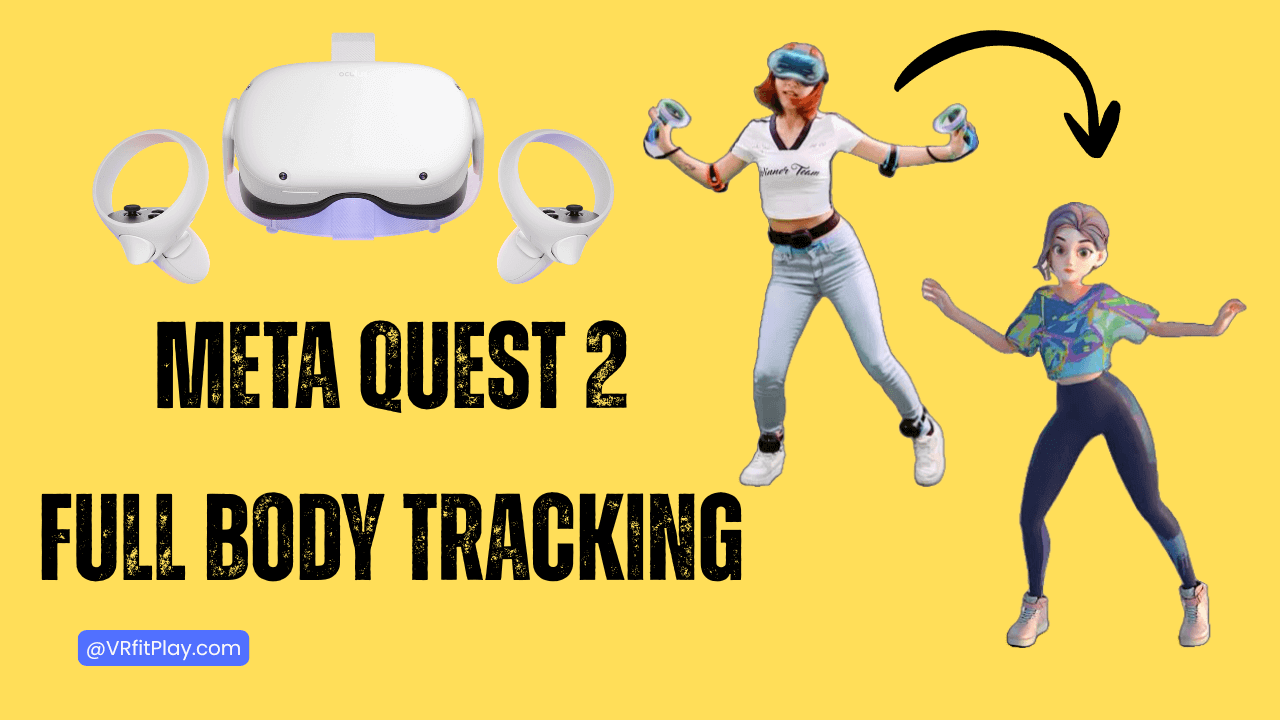So you’ve been boxing in FitXR, dancing in Just Dance VR, or chilling in VRChat, and now you’re asking yourself:
👉 “Wait… is there Oculus Quest full body tracking? Can I finally see my legs in VR?”
The short answer: Yes, it’s possible — but not straight out of the box.
The Quest 2 (technically the Meta Quest 2) doesn’t come with leg or hip tracking built in. But with the right Quest-compatible full body tracking gear, you can unlock a whole new level of immersion. Whether you’re into VR fitness, dance games, or just want to stop looking like a floating torso in VRChat, this guide covers everything you need.
🎯 Why Full Body Tracking Matters
VR without full body tracking feels… incomplete. You’ve got your head and hands, but your legs are just ghosting in the void.
When you add VR full body tracking for Oculus Quest 2, suddenly:
- Squats, lunges, and kicks are tracked for more accurate fitness.
- Avatars in VRChat or Neos VR finally move like YOU.
- Dance games like Just Dance VR actually register your footwork.
For fitness fans, this isn’t just about immersion — it’s about better workouts. With your lower body included, calorie burn is way more accurate. And let’s be honest, it just feels cooler to actually throw a kick that lands in VR.
Next Read: Best Martial Arts VR Games in 2025: Full Review of Top Picks
🦵 Does the Quest 2 Have Built-in Body or Leg Tracking?
Sadly, no. The Oculus Quest 2 standalone full body tracking option doesn’t exist natively. Right now, the headset only tracks:
- Your head
- Your controllers (hands)
That’s it. No hips, no knees, no feet.
Meta has teased AI-based leg tracking on the Quest Pro and Quest 3. But for Quest 2 owners? You’ll need third-party gear to make it happen.
Some people ask: “Is there full body tracking Oculus Quest 2 no PC?”
👉 The reality: Most solutions still need PC + SteamVR for proper calibration. True standalone full body tracking Oculus Quest 2 isn’t mainstream yet — but there are a few experimental (and limited) workarounds.

🏋️♂️ The Best Quest 2 Full Body Trackers in 2025
Here’s where things get exciting. If you’re ready to dive into body tracking, these are the top Quest 2 full body trackers right now:
1. SlimeVR (Affordable & Wireless)
- Open-source, budget-friendly trackers you strap to your body.
- Great for VRChat, casual workouts, and experimenting.
- Not as razor-accurate as Vive, but wireless freedom makes it fun.
💡 Best if you want cheap full body tracking Oculus Quest 2.
2. HaritoraX (Fitness-Friendly)
- Wireless, compact, made in Japan.
- Solid for VR dance and rhythm games.
- Setup is easier than DIY kits, though imports can be pricey.
3. Sony Mocopi (Super Portable)
- Six small motion sensors that link through your smartphone.
- Very lightweight and easy to clip on.
- Better for social VR than hardcore workouts.
4. Vive Trackers (with SteamVR Base Stations)
- The gold standard of VR tracking.
- Ultra-precise, used by VRChat pros, dancers, and streamers.
- But also the most expensive — you’ll need base stations and dongles.
5. DIY Kits
- Made by the community, for the community.
- Super cheap but very tech-heavy.
- Great for modders who enjoy tinkering.
👉 Quick breakdown:
- Want fitness tracking + casual VR? Go with SlimeVR or Mocopi Pro Kit.
- Want perfection in VRChat? Vive Trackers are unbeatable.
- Want to experiment on a budget? DIY or HaritoraX might be your jam.
💪 Best Quest 2 Full Body Trackers for Fitness
If your main goal is working out in VR, here’s where things get interesting.
Body tracking makes a massive difference in apps like:
- Les Mills Bodycombat 🥊
- FitXR 🏋️♂️
- Supernatural 💃
Why? Because the system isn’t just guessing your moves. It’s actually following your squats, kicks, and lunges. That means better calorie counts and more realistic training.
For fitness players, the winners are:
- 🟢 SlimeVR (cheap + wireless, great for long sessions)
- 🟣 Mocopi (easy to wear, no heavy gear)
If you’re asking “Which are the best quest 2 full body trackers for fitness?” — these two top the list.
Next Read: How to Mod Beat Saber – Custom Songs & More
Quest 2 Full Body Trackers Compared (2025)
| Tracker | Price Range | Works Standalone? | Best For | Pros | Cons |
|---|---|---|---|---|---|
| SlimeVR | $200–$300 | ❌ Needs PC | Cheap VRChat + Fitness | Affordable, wireless, open-source | Not 100% precise, requires DIY setup |
| HaritoraX | $300–$400 | ❌ Needs PC | Fitness & Dance | Lightweight, comfy, wireless | Slightly pricey, limited stock |
| Sony Mocopi | $450–$500 | ✅ Yes (via phone) | Casual Fitness & Social VR | Small, portable, no base stations | Lower accuracy, laggy for fast moves |
| Vive Trackers (with Base Stations) | $600+ | ❌ Needs PC | VRChat & Hardcore Users | Ultra-accurate, best for pro setups | Very expensive, needs external base stations |
| DIY / Community Kits | $100–$200 | ❌ Needs PC | Tinkerers on a budget | Cheapest option, customizable | Complicated setup, not plug-and-play |
🎮 Games That Shine With Full Body Tracking
Not every VR game supports body tracking, but the ones that do? WOW.
Here’s where it shines:
- VRChat – No more floating torso life.
- Just Dance VR – Footwork finally matters.
- Dance Central VR – True rhythm-body sync.
- Blade & Sorcery (modded) – Feel like a martial arts god.
- Fitness mods – Some fitness apps are adding unofficial body tracking support.
⚙️ Setup: How to Get Full Body Tracking Working
Alright, so how do you actually set it all up? Here’s the quick guide:
- Install SteamVR on your PC
- Connect Quest 2 using Air Link or Virtual Desktop
- Pair your trackers (SlimeVR, Vive, Mocopi, etc.)
- Calibrate in SteamVR
- Launch your game → Dance, squat, kick!
👉 If you were hoping for true standalone full body tracking Oculus Quest 2 — we’re not quite there yet. But this setup works like a charm if you don’t mind using your PC.
🔋 Pros & Cons of Full Body Tracking on Quest 2
Pros:
- Full immersion (legs + hips + torso)
- More accurate fitness workouts
- Amazing for VRChat and social games
Cons:
- Pricey, especially with Vive Trackers
- Setup time + calibration can be a pain
- Limited native Quest 2 support (PC required for now)
🔮 The Future of Quest Body Tracking
Meta has already shown off AI leg tracking on Quest Pro and Quest 3. It uses clever algorithms to “predict” leg positions from head + hand data.
But for now, if you want quest compatible full body tracking that’s reliable, third-party trackers are the only real option.
Will Quest 2 get it natively? Honestly — unlikely. But the next generation of standalone VR will probably make body tracking a standard feature.
🏁 Final Thoughts
So, is full body tracking worth it on Quest 2?
👉 If you’re into fitness + casual VR, go SlimeVR or Mocopi.
👉 If you’re a VRChat power user, invest in Vive Trackers.
👉 If you want cheap full body tracking Oculus Quest 2, experiment with DIY kits.
It’s not plug-and-play yet, but if you’re serious about VR immersion, adding full body tracking Oculus Quest 2 is absolutely worth the effort.

Leave a Reply